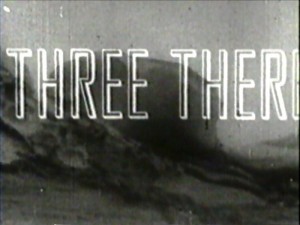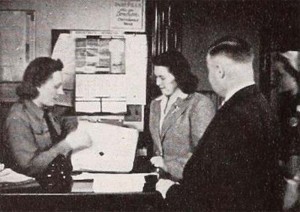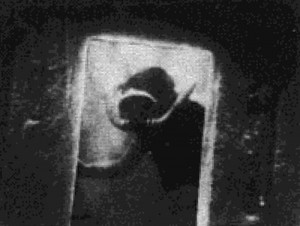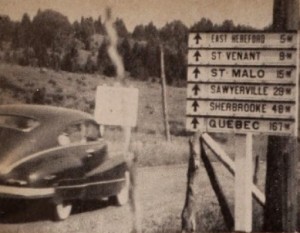
Sub-title: "Galiano Island 1940" Summary: "Impressionistic record of a sojourn on Galiano Island over a Labour Day weekend, with Oscar Burritt, Dorothy Fowler [later Burritt] and Margaret Roberts." (British Columbia Archives)

"In the film, a young woman receives a letter about her brother's arrival in the army, which prompts her to ask: "What can I do to help in this war?" The film's answer is to give blood, and it proceeds to show the process of the young woman and her father giving blood at the local Red Cross clinic. The entire procedure is shown, including medical examinations and long sequences in the clinic that explain all the parts of the process. Eventually, this vivid color film shows the actor actually giving blood. To provide drama the film shows an alternation between shots of the woman at church and her injured brother resting in a hospital after Dieppe; it soon reveals that he is being treated with blood transfusions, and we can see that he will soon recover. The film ends with a sequence of shots showing the solider walking down a snowy Ottawa street with a cane, returning home. When he sees from a sign in the window that the woman there gave blood, he is touched by her lifesaving contribution. This silent film is thirty minutes long and blends elements of fictional or dramatized scenes with process sequences at the Ottawa Blood Donor Service. Shot in 16mm color film, it is both a vivid and professional-looking production; indeed, it exemplifies both elements of the practical amateur genre (creative engagement with practical issues) and the wartime necessity of the moment" (Tepperman 93).

"Tobermory Shipwrecks provides some good views of sunken ships in the Tobermory region, located at the northern tip of the southern Ontario peninsula that separates Lake Huron from Georgian Bay. Much of the underwater photography is well done, and the producer gives tips on underwater photographic equipment and how to use it" PSA Journal, Sept. 1965, 51.
"Film documents the Royal Visit of King George VI and Queen Elizabeth in Toronto May 22, 1939. Film shows the royal party traveling through the city and at various locations including Union Station, City Hall, Queen's Park, and Exhibition Place. The Toronto Movie Club presents the film, which was shot by over 25 club members staged at different locations. "The Toronto Movie Club : Its first fifty years, 1934-1984" pp. 14, 15, provides additional details about this film including the fact that many copies of the film were sold and one copy was presented to the King and Queen." Archives of Ontario.
"An intelligent, informative story of glaciers, rivers and meadows in the Canadian Rockies. Music and narration well above average. In a land frequented by many vacationing photographers who usually shoot conventional scenes from the main highway, the advantages gained from striking off on foot over the trails are pleasingly evident in this enjoyable film" PSA Journal, Dec. 1955, 35.
"A lover of wild life and good fishing, Russell Jameson has a real fishing picture for those who would like to go into the wilds of British Columbia where the lakes and streams are generously populated with big ones which are willing to make the anglers' acquaintance. Most of the fishing is with barbless hooks for the sport and catch is returned to the stream uninjured. The musical score and sound effects add a great deal to this picture. It will tempt any fisherman with the time and money to indulge in the sport" PSA Journal, Nov. 1958, 48.
"Under the Maple Leaf, by Hamilton H. Jones, ACL, is a partially refilmed and entirely reedited version of last year's award winner, Canadian Capers. A splendid picture a year ago, its new and additional sequences now bring to the film a photographic beauty plainly of the very first rank. A sequence of the morning mist rising from a lake deserves particular mention. Mr. Jones's considerable skill with his camera has increased in stature and may not yet have reached its full flowering. For this accomplishment his work has been given a place of honor in these selections. In the reluctant estimation of the judges, however, the editing and cutting of Under the Maple Leaf so far lagged behind its generally matchless beauty as to rob the film of its fullest emotional power. This factor only prevented Mr. Jones from repeating this year his full triumph of a year ago." Movie Makers, Dec. 1933, 523-524.
"Under the Maple Leaf, a new version of the perennial Canadian travel study by Hamilton H. Jones, ACL, is more beautiful and even more satisfying than its forerunners. Ineligible for current Ten Best, because of the fact that a small part of the present material has been viewed and listed in previous selections, the new release is included in the Honorable Mention category as a tribute to the dexterity with which the material, old and new, has been combined and the high quality of the added color sequences. The same flawless photography and clever sequencing which marked previous versions are again present. The disc sound accompaniment (in revised form) is deftly handled, making a thrilling addition to the film. Color is interspersed successfully with black and white sequences in a way that seems to obviate criticism of the mixture." Movie Makers, Dec. 1935, 553.

"'Vacation Highlights,' as the title implies, is a record of a vacation trip, but instead of the usual array of catch-as-can shots which make up so many vacation record films, Terry Manos has given this excellently photographed narrative substance by employing inserts of a letter to his wife and daughter, describing his trip, and a number of tie-in shots of the two to knit the whole into a pleasant continuity. The picture is remarkable, not so much from its narrative standpoint as for its consistency in exposure. There is not a measurable difference in exposure in any scene throughout the picture. The picture depicts the start of the trip by automobile, which takes the travelers across the U.S. border into Canada and thence through the province of Quebec. On the return trip they visit such interesting sights as a wood pulp mill and the famed Ausabel Chasm, in upper New York. The camera treatment of the pulpwood sequence and of the Chasm scenes definitely mark this filmer as a photographer of promise. Manos used a 16mm. Bolex camera and Kodachrome daylight type film." American Cinematographer, Apr. 1950, 134.
Total Pages: 12